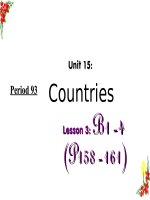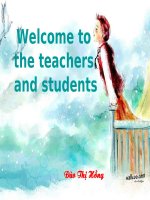Tiếng Anh 6 Unit 15
Bạn đang xem bản rút gọn của tài liệu. Xem và tải ngay bản đầy đủ của tài liệu tại đây (133.16 KB, 13 trang )
Tiếng Anh 6 Unit 15
UNIT 15: COUNTRIES
A. We are the world. (A1, 2, 3)
I. Objectives
- Sts will be able to talk about countries, nationalities and languages.
II. Language content
1. Vocabulary :
- world (n) thế giới – speak (v) nói
- country (n) quốc gia – nationality (n) quốc tịch
- language (n) ngôn ngữ
2. Structures:
Where are you from?
I’m from Viet Nam
Where is she from ?
She is from Viet Nam
III. Teaching aids
IV. Procedure
* Organization
* Check up the previous lesson
* New lesson
1). Warm up
Teacher’s activities Students’ activities Content
- T presents the new lesson.
- T asks sts some questions.
- T gives feedback and presents
the lesson.
- Sts listen and write down.
- Sts listen and answer.
- What’s his name?
- Where is he from?
- Which language does he speak?
2). Presentation
- T asks sst to look at the pictures.
- T asks sts to recognize the
countries where each people come
from.
- T corrects and asks sts to listen
to the tape.
- T presents new words and review
structures.
- T gives feedback.
- Sts look at the pictures.
- Sts look at the pictures and
answer.
- Sts listen to the tape.
- Sts write down and read the
words loudly.
A1. Listen and repeat.
Canada – canadian
France – french
China – chinese
USA – English
Japan – Japanese
Great Britain
Australia – Australian
Viet Nam – Vietnamese
Vocabulary :
- world (n) thế giới
- speak (v) nói
- country (n) quốc gia
- nationality (n) quốc tịch
- language (n) ngôn ngữ
Structures:
Where are you from?
I’m from Viet Nam
Where is she from ?
She is from Viet Nam
3). Practice
- T asks sts to read all the pictures
again.
- T gives feedback.
- T asks sts to ask and answer the
questions.
- T checks and gives feedback.
- T asks sst to look at the picture
- Sts practice loudly.
- Sts practice the questions again.
A1. Now ask and answer.
My name’s Laura
I’m from Canada
Where is Laura from?
He is from Canada.
Where is … from?
on page 155.
- T asks sts to notices the
structures.
- T asks sts to practice the text
loudly
- T gives feed back.
- Look at the picture on page 155.
- Notices the structures.
- Practice the text loudly
He is from ………….
A2. Listen and read.
My name’s Minh.
I from Viet Nam
I speak Vietnamese
Minh is from Viet Nam.
He speaks Vietnamese.
Laura is from Canada.
He speaks English.
4). Consolidation
- T asks sts to notice the countries,
nationalities, and languges.
- Ask Sts practice asking and
answering the questions using the
table.
- T checks and gives feedback.
- Sts look at the table and read
loudly.
- Sts practice asking and
answering the questions using the
table.
A3. Listen and repeat.
Minh is from Viet Nam.
He is Vietnamese.
He speaks Vietnamese.
Yoko is from Japan
She is Japanese.
She speaks Japanese.
…………………
5). Homework
- Memorize new words and structures.
- Write the answers in the note book
- Prepare A4, 5, 6, 7 on pages 156-157.
V. Feedback
UNIT 15: COUNTRIES
A. We are the world. (A4, 5, 6, 7)
I/ Aims :
Students will be able to ask and answer about countries, nationalities and languages.
II/ Language contents :
1. Vocabulary :
- wet (adj) ẩm ướt
- tower (n) cái tháp
2. Structures:
- Where are you from?
I’m from Viet Nam
- Which language do you speak?
I speak Vietnamese
- What are your nationality?
I’m Vietnamese
III/ Teaching aids :
Cassette tape and player, text book, chalks….
IV/ Procedures :
Teacher’s and student’s activities Content
- T asks sts some questions.
- Sts listen and answer.
- T gives feedback and presents the lesson.
- Sts listen and write down.
- T asks sst to ask and answer questions using the
table in exercise 3.
- Sts Practice asking and asnwering the questions.
- T checks and gives feedback.
* Previous Lesson : (5’)
- What’s his name?
- Where is he from?
- Which language does he speak?
* New lesson :
UNIT 15: COUNTRIES
1. A. We are the world. (A4, 5, 6, 7)
1/ Warm – up (10’)
A4. Make dialogues.
Thu: Who’s that?
Chi: That’s …
Thu: Where is he/ she from?
- T asks sts to look at the postcard and read.
- Sts look at the postcard and read.
- T notices some words and content of the postcard.
- Sts listen and write down.
- T corrects and asks sts to read the text loudly.
- Sts read loudly.
- T asks sts to write the postcard from Minh to Nhan
using the given words.
- Sts write and give the answers.
- T checks and gives feedback.
- T asks sts to ask and answer the questions about
themselves.
- Sts practice asking and answering the questions
again.
- T checks and gives feedback.
- T asks sts to review the structures on page 157.
- Sts takenotes.
- T asks sts to read remember again.
- Sts read loudly.
Chi: He/ She’s from ……….
Thu: What’s his/ her nationality?
Chi: He/ she’s ………………
Thu: Which language does he/ she speak?
Chi: He/ She speaks …………
2/ Presentation (15’)
A5. Write.
- wet (adj) ẩm ướt
- tower (n) cái tháp
Dear Nhan,
I am on vacation in ……… The weather is
………… and …………
I’m traveling by ……… and visiting ………
Tomorrow, I’m going to visit ………
Love,
Minh
3/ Practice(10’)
A6. Answer.
a/ My name’s …………
b/ I’m ………………….
c/ I’m from …………….
d/ I speak …………………
e/ I go to Song Doc secondary school.
f/ I’m in grade 6.
4/ Consolidation(5’)
A7. Remember.
Where are you from?
I’m from VietNam.
- T asks sts to do the homework.
- Sts write down and do exercise at home.
Where is he/ she from?
He/ She’s from Japan.
Which language do you speak?
I speak Vietnamese.
……
5/ Homework
- Memorize new words and structures.
- Write the answers in the note book.
- Prepare B1, 2, 3 ,4, 5 on pages 158-161.
V/ Feedback :
UNIT 15: COUNTRIES
B. Cities, buildings and people(B1, 2, 3, 4, 5)
I/ Aims :
Students will be able to talk about cities, buildings and people using comparisons.
II/ Language contents :
1. Vocabulary :
- building (n) tào nhà, cao ốc
- population (n) dân số
- capital (n) thủ đô
- milion : triệu
- high (adj) cao
- long (adj) dài
- thick (adj) dày
- meter (n) mét
2. Structures:
Comparatives and superlatives.
A small house
A smaller house
A smallest house
III/ Teaching aids :
Cassette tape and player, text book, chalks, pictures (B1, 2, 3, 4).
IV/ Procedures :
Teacher’s and student’s activities Content
- T presents the new lesson.
- Sts listen and write down.
- T asks sst to look at the pictures.
- Sts look at the pictures.
- T asks sts to compare the pictures.
- Sts look at the pictures and answer.
- T corrects and asks sts to listen to the tape.
- Sts listen to the tape and repeat.
- T presents new words and
structures.
- Sts write down and read the words loudly.
- T asks sts to read all the pictures again.
- Sts read loudly.
- T gives feedback.
- T asks sts to look at the pictures on page 159 and
notices the structures and new words.
* New lesson
UNIT 15: COUNTRIES
1. A. Cities, buildings and people
(B1, 2, 3, 4, 5)
1/ Warm – up (5’)
Look at the pictures and compare.
The big buildings/ the small houses/ the tall buildings.
Þ Cities, buildings and people
2/ Presentation (20’)
B1. Listen and repeat.
- building (n)
a big building
a bigger building
the biggest building
a small house
a smaller house
the smallest house
a tall building
a taller building
- Sts take notes
- T asks sts to practice the text loudly
- Sts listen to the tape and read the text.
- T asks sts to ask and answer the questions.
- Sts ask and answer the questions.
- T gives feed back.
- T asks sts to listen to the tape and notice the new
words on pages 160-161.
- Sts listen to the tape and read the new words.
- T asks sts to read the text loudly.
- Sts read the text loudly.
- T asks sts to ask and answer the questions.
- Sts practice asking and answering the questions.
- T checks and gives feedback.
- T asks sts to read the remember again.
- Sts read loudly.
- T asks sts to do the homework.
- Sts write down and do exercise at home.
the tallest building
B2. Listen and read.
- population (n) dân số
- capital (n) thủ đô
- milion : triệu
a/ No. It’s smaller than HCM city.
b/ The biggest city in the world is Mexico city.
c/ Tokyo is bigger than london.
3/ Practice(10’)
B3. Listen and read.
- high (adj) cao
- meter (n) mét
Petronas twin Towers is taller than Sears tower.
4/ Consolidation(10’)
B4. Listen and read.
- high (adj) cao
- long (adj) dài
How long/ high/ thick is the great Wall?
It’s is ……. meters high/ long/ thick.
B5. Remember.
long, longer, the longest is longer than
big, bigger, the biggest is bigget than
tall, taller, the tallest is taller than …
5/ Homework
- Memorize new words and structures.
- Write the answers in the note book.
- Prepare C1, 2 on pages 162-164.
V/ Feedback :
UNIT 15: COUNTRIES
C. Natural features (C1, 2)
I/ Aims :
Students will be able to describe natural features; ask and answer about natural features in Viet Nam.
II/ Language contents :
1. Vocabulary :
- feature (n) nét, đặc trưng
- natural (adj) tự nhiên
- great (n) tuyệt vời, to lớn
- forest (n) rừng
- desert (n) sa mạc
- rain (n) mưa
2. Structures:
We have many/ a lot/ lots of beaches.
We have much/ a lot/ lots of rain.
It has many/ a lot of/ lots of ….
It doesn’t have ……
III/ Teaching aids :
Cassette tape and player, text book, chalks, pictures (C1).
IV/ Procedures :
Teacher’s and student’s activities Content
- T asks sts to read the text B2, 3, 4 on pages 159-161.
- Sts read the text and answer the questions.
- T checks and gives marks.
- T presents the new lesson.
- Sts listen and write down.
- T asks sts to look at the pictures on pages 162-163
* Prevoius lesson: (10’)
B2, 3, 4
Which is taller?
How long/ high/ thick is the Great Wall?
* New lesson
UNIT 15: COUNTRIES
and asks some questions.
- Sts look at the pictures and answer.
- T gives feedback and presents the lesson.
- T corrects and asks sts to listen to the tape.
- Sts listen to the tape.
- T presents new words and
structures.
- Sts write down and read the words loudly.
- T gives feedback.
- T asks sts to read all the pictures again.
- Sts read loudly.
- T gives feedback.
- T asks sts to complete the passage using the words
from the pictures.
- Sts read the passage and complete.
- T asks sts to read the sentences again.
- Sts read loudly.
- T gives feedback.
- T asks sts to ask and answer the questions.
- Sts practice the questions again.
- T checks and gives feedback.
- T asks sts to do the homework.
- Sts write down and do exercise at home.
1. A. Natural features (C1, 2)
1/ Warm – up (5’)
- What is it?
- What are they?
- Where is it?
Mountains, rivers, rain, beaches….
Þ Natural features.
2/ Presentation (15’)
C1. Listen and read.
Vocabulary :
- feature (n) nét, đặc trưng
- natural (adj) tự nhiên
- great (n) tuyệt vời, to lớn
- forest (n) rừng
- desert (n) sa mạc
- rain (n) mưa
Structures:
We have many/ a lot/ lots of beaches.
We have much/ a lot/ lots of rain.
It has many/ a lot of/ lots of ….
It doesn’t have ……
3/ Practice(10’)
a/ mountains
b/ rivers
c/ lakes
d/ rain e/ forests
f/ beaches g/ deserts
4/ Consolidation(5’)
C2. Look at the pictures again. Ask and answer.
Does Viet Nam have any mountains ?
Yes, it does
No. it doesn’t.
5/ Homework
- Memorize new words and structures.
- Write the answers in the note book.
- Prepare C3, 4 on pages 165.
V/ Feedback :
UNIT 15: COUNTRIES
C. Natural features (C3, 4)
I. Objectives
- Students will be able to describe natural features; ask and answer about some rivers, mountains in Viet
Nam and in the world.
II. Language content
1. Vocabulary :
- start (v) bắt đầu
- flow (v) chảy
2. Structures:
Which is the longest river/ highest mountain in Viet Nam?
………. is the longest river/ highest mountain in Viet Nam.
III/ Teaching aids :
Cassette tape and player, text book, chalks ……
IV. Procedure
* Organization
* Previous lesson
* New lesson
1). Warm up
Teacher’s activities Students’ activities Content
- T presents the new lesson.
- T asks sts some questions.
- T gives feedback and presents
the lesson.
- Sts listen and write down.
- Sts listen and answer.
Which is the longest river in Viet Nam?
Which is the highest mountain in Viet
Nam?
Where does the Mekong river start?
Þ
2). Presentation
- T asks sts to listen to the tape.
- T presents new words and
structures.
- T gives feedback.
- Sts listen to the tape.
- Sts write down and read the
words loudly.
C3. Listen and read.
Vocabulary :
- start (v) bắt đầu
- flow (v) chảy
Structures:
Which is the longest river/ highest
mountain in Viet Nam?
………. is the longest river/ highest
mountain in Viet Nam.
3). Practice
- T asks sts to listen to the tape
again.
- T asks sts to read text loudly.
- T gives feedback.
- T asks sts to notice the questions
on page 165.
- T asks sts to read the remember
again.
- T gives feedback
- Sts listen to the tape.
- Sts read loudly.
- Sts take notes.
- Sts read loudly.
C3.
There are two long rivers in Viet Nam. The
red River is 1, 200 kilometers long. It starts in
China and flows to the Gulf of Tonkin.
The MekongRiver is longer than the Red
River. It starts in Tibet and flows to the Bien
Dong.
C4. Remember.
We have many/ a lot/ lots of beaches.
We have much/ a lot/ lots of rain.
4). Consolidation
- T asks sts to do the written test
of 15’.
- Sts do the test and give their
assigments.
I. Use the correct form of the verbs.
(4M)
1. He is…a video game now ( play)
2.Lan …aerobics every day ( do)
3. They …TV at the moment(watch)
4. we usually…fishing in the summer
(go)
II/ Choose the correct words to
complete the sentences (4M)
1. It’s very…………. in the summer. a.
Cold b. cool c. hot
d. warm
2. It’s very………… in the winter. a.
Cold b. cool c. hot
d. warm
3. …is the weather like in the summer?
a. What b. which
c. how d. who
4. When it’s hot, he goes……………
a. Jogging b.
swimming c. sailing
IV/ order the words in sentences.(2M)
1, summer/ in/ we / the / often/
swimming/go
ð………………………………
3, He / go/ is / going/ to / camping /
next / week.
ð………………………………
5). Homework
- Memorize new words and structures.
- Write the answers in the note book.
- Prepare Unit 16 “A1, 2” on page 166.
V. Feedback









